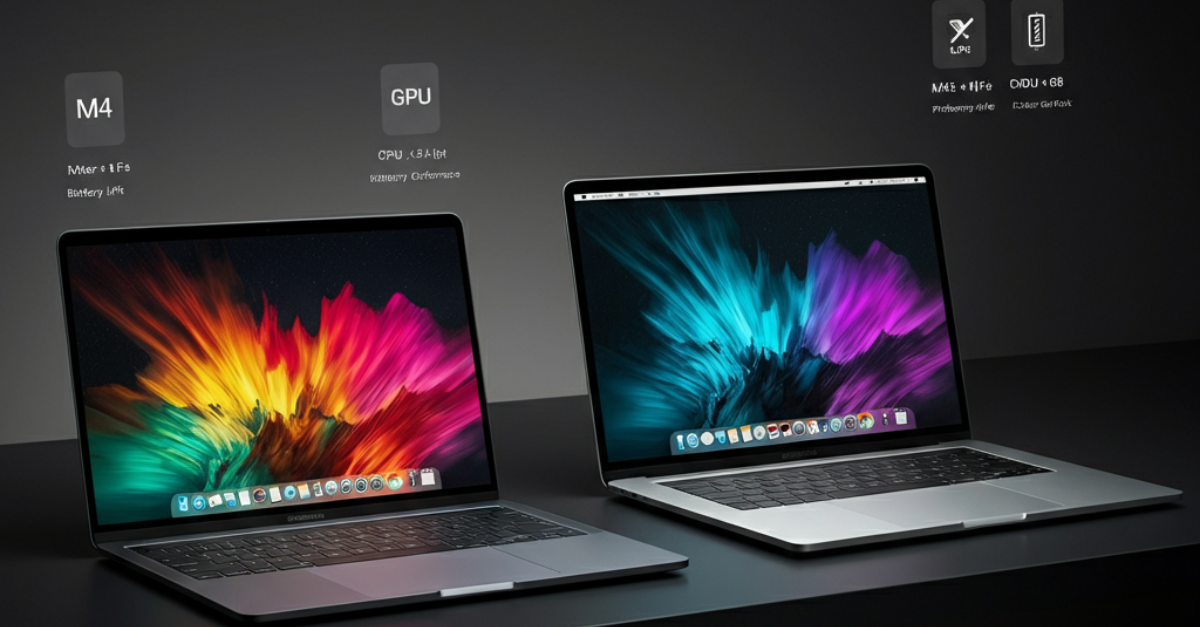Apple enthusiasts have a lot to talk about with the arrival of the M4 MacBook Pro lineup. Apple’s latest generation promises faster performance, stunning display enhancements, and better efficiency, further solidifying its place in the premium laptop market. But how does it stack up against its predecessor, the M3 MacBook Pro, which itself brought impressive upgrades?
If you’re deciding whether upgrading to the M4 is worth it or simply curious about the latest in Apple’s innovation, we’re here to break it all down.
From design and build to performance and battery life, this guide will help you understand how the M4 advances the MacBook lineup and who it’s best suited for.
Design and Build
Let me mention a detailed comparison table of the M4 MacBook Pro vs. M3 MacBook Pro, highlighting it’s key specs and differences:
| Feature | M3 MacBook Pro | M4 MacBook Pro |
|---|---|---|
| Chip Options | M3, M3 Pro, M3 Max | M4, M4 Pro, M4 Max |
| CPU Cores | Up to 12-core CPU | Up to 16-core CPU |
| GPU Cores | Up to 40-core GPU | Up to 40-core GPU (with improved AI performance) |
| Performance | Standard Apple Silicon efficiency | Up to 1.3x faster than M3 |
| Memory (RAM) | Up to 128GB unified memory | Up to 128GB unified memory |
| Display | Liquid Retina XDR (600 nits SDR) | Liquid Retina XDR (1000 nits SDR) |
| HDR Brightness | 1600 nits (Peak) | 1600 nits (Peak) |
| Nano-Texture Option | ❌ No | ✅ Yes |
| Camera | 1080p HD | 12MP Center Stage with Desk View |
| External Display Support | 2 displays (M3 Pro & Max models) | 2 displays (M4 base), 4 displays (M4 Max) |
| Ports | Thunderbolt 4, HDMI 2.1 | Thunderbolt 5, HDMI 2.1 |
| Wi-Fi & Bluetooth | Wi-Fi 6E, Bluetooth 5.3 | Wi-Fi 6E, Bluetooth 5.3 |
| Battery Life | Up to 22 hours (M3 Pro) | Up to 24 hours (M4 Pro) |
| Color Options | Silver, Space Gray | Space Black, Silver |
| Starting Price | $1,599 (M3), $1,999 (M3 Pro) | $1,999 (M4 Pro) |
Same Premium Build, with a New Twist
Apple has largely maintained its signature slim and sleek design, making both the M4 and M3 models look almost identical at first glance. However, there are some key refinements in the M4 lineup worth noting.
The M4 MacBook Pro offers a new Nano-Texture Display option, perfect for reducing glare—a welcome upgrade for professionals who work in bright environments or outdoors.
- Colors: All M4 models are available in Silver and Space Black, with Space Black extended across the entire range (previously exclusive to higher-end models).
- Dimensions and Weight: Both models maintain the same dimensions and light weight. For instance, the 14-inch M4 MacBook Pro starts at 3.4 pounds—ideal for portability.
For creatives and professionals on the go, the robust build combined with subtle refinements adds up to a machine that feels both reliable and sophisticated.

Ports Upgraded
Both M3 and M4 models share a similar port lineup, including MagSafe charging, an HDMI port, and an SDXC card reader. However, the M4 Pro and M4 Max models boast Thunderbolt 5 connectivity, delivering up to 120GB/s performance a substantial leap for professionals involved in high-performance workflows like video editing or 3D rendering.
While the design remains mostly unchanged, the Thunderbolt 5 upgrade and Nano-Texture Display option give the M4 a slight edge for those seeking functional improvements.
Display Quality
Apple continues to bring best-in-class displays to its laptops with its Liquid Retina XDR technology, and the M4 turns things up another notch.
- Both the M3 and M4 models feature Promotion with refresh rates of up to 120Hz and 254 PPI resolution, ensuring buttery-smooth visuals.
- The M4 MacBook Pro takes the crown in brightness levels, now offering SDR brightness of up to 1000 nits, a significant jump from the M3’s 600 nits for SDR.
Additionally, the Nano-Texture Display option on the M4 is a game-changer for reducing glare, making it an attractive choice for professionals working in varied lighting conditions.
Performance
When it comes to performance, the M4 lineup is a powerhouse. With advancements in the M4, M4 Pro, and M4 Max chips, this year’s MacBook Pro significantly outpaces the M3 in several key areas.
- CPU and GPU: The M4 boasts up to 16-core CPUs and 40-core GPUs, with accelerated ray tracing for graphics-heavy workflows like game development and 3D rendering.
- Unified Memory Bandwidth: The M4 features 547GB/s memory bandwidth compared to the M3’s 400GB/s, enabling faster multitasking and smoother performance with heavy applications.
- Neural Engine: The M4’s Neural Engine is 2x faster than the M3, enhancing AI-powered features such as video editing, speech recognition, and image processing.
Real-World Usage
For professionals in video editing, animation, and coding, the M4’s hardware-accelerated ProRes and AV1 decode engines will make workflow significantly faster. Apple claims the M4 Max CPU is 20% faster than its M3 counterpart, with M4 Pro delivering up to 30% better performance for 3D visualization tasks.
For those with demanding workloads that involve graphics processing or AI-enhanced tasks, the M4 is a clear winner. However, the M3 remains a very capable performer for everyday use and lighter creative work.
Battery Life
Battery efficiency is a hallmark of Apple Silicon, and the M4 MacBook Pro raises the bar further.
Device | Wireless Web | Video Playback |
|---|---|---|
14” M4 MacBook Pro | 16 hours | 24 hours |
14” M3 MacBook Pro | 15 hours | 22 hours |
The M4 models offer longer runtimes across the board for demanding tasks. For instance, video playback sees an improvement of over 2 hours compared to the M3, thanks to its more efficient chip and better thermal management.
Fast charging remains available, and both laptops include their respective power adapters (70W to 140W, depending on the model).

Who Should Upgrade?
Reasons to Choose the M4 MacBook Pro
- You need maximized performance for tasks like 3D rendering, video editing, or heavy multitasking.
- You want Thunderbolt 5 connectivity or Nano-Texture Display.
- Longer battery life is a must-have.
Reasons to Stick with the M3 MacBook Pro
- You already own an M3 that meets your needs perfectly.
- Your workflows are lightweight, or you’re a casual user.
- You’d like to save money while still enjoying power and efficiency.
If you want more specs here they are:
| Feature | M3 MacBook Pro | M4 MacBook Pro |
|---|---|---|
| AI & Machine Learning | Standard Neural Engine (16-core) | Improved AI processing with enhanced Neural Engine |
| Ray Tracing & Graphics | Hardware-accelerated ray tracing | Faster ray tracing and mesh shading for smoother visuals |
| Cooling System | Standard active cooling (fans) | Enhanced cooling efficiency for high-performance tasks |
| SSD Read/Write Speed | High-speed SSD | Potential improvements in SSD speed (official numbers not yet disclosed) |
| Audio Improvements | Spatial Audio with Dolby Atmos | Improved Spatial Audio with enhanced clarity |
| FaceTime Mic System | Studio-quality 3-mic array | Enhanced studio-quality 3-mic array with better noise reduction |
| Security Features | Secure Enclave, Touch ID | Secure Enclave, Touch ID (with minor optimizations) |
| Weight | ~3.5 lbs (14-inch), ~4.7 lbs (16-inch) | Similar weight but slightly optimized chassis |
| macOS Support | macOS Sonoma (Upgradeable) | Ships with macOS Sequoia |
Final Verdict: Is It Worth Upgrading?
If you own an M3 MacBook Pro, the M4 might not be a necessary upgrade unless you need faster processing, improved AI capabilities, or Thunderbolt 5 support. However, if you’re coming from an M1 or M2 MacBook Pro, the M4 models offer a major leap in power, battery life, and display technology.
Know how to reset your MacBook, if don’t you are at right place.
Whether you prioritize performance, display upgrades, or battery longevity, both the M3 and M4 MacBook Pro deliver value tailored to different needs.

